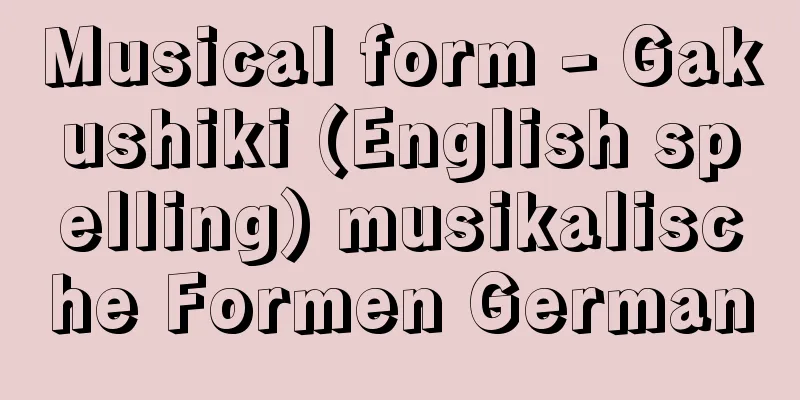Musical form - Gakushiki (English spelling) musikalische Formen German

|
A musical term referring to the basic principles that compose a piece of music. Sometimes called musical form, musical form has two concepts: (1) principles from an aesthetic point of view regarding sound materials and musical content, and (2) the specific form of an individual piece of music that has been formed historically and empirically. Strictly speaking, only the latter is synonymous with musical form. Such principles of musical composition vary among all ethnic groups and eras, but when referring to musical form, it is almost always limited to Western art music. Musical forms in this sense can be further broadly divided into "basic musical form" and "applied musical form." [Toshiaki Kurosaka] Basic MusicWhen we look at music from the perspective of melody, the smallest unit is the motive, which develops into a short section and then a large section. A motive usually consists of two measures, and when two of these are combined, a short section and a large section are made up of four and eight measures, respectively. This eight-measure structure is called a "large section structure" and is considered the most basic unit of music. Based on this large section structure, basic musical forms can be divided into three types depending on the number of sections: one-part form (one large section), two-part form (two sections), and three-part form (three sections). The one-part form is the large section structure itself, while the two-part form can be divided into the following three types based on its structure: (1) Repetition The same large section is repeated (a-a). (2) Contrast Different large sections are combined (a-b). (3) Modified repetition The following large section is repeated with changes (a-a'). The three-part form also has the unity of presentation-contrast-representation, but when the repetition is exact, it is called "mechanical repetition" (a-b-a), and when the repetition is modified, it is called "modified repetition" (a-b-a'). These principles of composition become more complex and become the basis for the formation of larger musical forms. [Toshiaki Kurosaka] Applied MusicIt refers to the structural principles that govern a piece of music as a whole, and its important forms can be classified as follows: Repetitive form This is a form in which a musical idea is first presented and then repeated with a variation, or with a different character inserted between each repetition, and its unifying principle is the partial contrast of the ideas and their return to the initial idea. Continuous form A form found mainly in vocal polyphony. It emphasizes parallel continuity over partial contrast or repetition, and cannot be diagrammed like the repetitive form. Multi-movement form A form in which several pieces of various single-movement forms are combined to form a larger piece. It can be called a musical genre. Therefore, these terms are often used as titles for each piece (e.g., Mozart's Piano Sonata in C major, Bach's St. Matthew Passion). Furthermore, in modern music, the concept of traditional musical form is being neglected and even rejected. Modern music is not perceived as a form, but as a process of creating a form. [Toshiaki Kurosaka] ©Shogakukan "> Classification of applied music Source: Shogakukan Encyclopedia Nipponica About Encyclopedia Nipponica Information | Legend |
|
楽曲を構成する基本的原理を意味する音楽用語。音楽形式という場合もあるが、音楽形式には、(1)音素材や音楽内容に関して美学的見地からみた原理、(2)歴史的、経験的に形成されてきた個々の楽曲の具体的形式、の2種類の概念があり、厳密には後者に限って楽式と同義になる。そういった楽曲の構成原理は、あらゆる民族や時代によってさまざまであるが、楽式という場合、その対象はほとんど西洋の芸術音楽に限られる。この意味をもつ楽式はさらに「基礎楽式」と「応用楽式」とに大別され、言及されることができる。 [黒坂俊昭] 基礎楽式旋律を中心に音楽をみた場合、その最小の単位は動機であり、それが発展して小楽節、さらに大楽節が形成される。通常、動機は2小節からなり、それが二つずつ組み合わされてできる小楽節と大楽節とは、それぞれ4小節と8小節とからなる。こうして構成される8小節の構造は「大楽節構造」とよばれ、音楽のもっとも基礎的なまとまりとして取り扱われる。この大楽節構造を基に基礎楽式は、その数に応じて、一部分形式(大楽節が1個)、二部分形式(2個)、三部分形式(3個)の3種類の形式が成立する。一部分形式は大楽節構造そのものであるが、二部分形式はその構造上、次の三つのタイプに分けられる。(1)反復 同一の大楽節が繰り返される(a―a)。(2)対照 異なる大楽節が組み合わされる(a―b)。(3)修飾的反復 後ろの大楽節が変化しながら反復する(a―a′)。また三部分形式は、提示―対照―再現という統一をもっているが、再現において正確な反復がなされる場合は「機械的再現」(a―b―a)、修飾的に反復がなされる場合は「修飾的再現」(a―b―a′)とよばれる。これらの構成の原則はさらに複雑になり、より大きな楽式の形成原理の基となる。 [黒坂俊昭] 応用楽式楽曲全体にわたる構成上の原理のことで、その重要な形式は次のように分類される。 反復形式 これは、最初に一つの楽想を提示し、それを変奏して反復するか、あるいは性格の異なる部分を挟んで反復するかによって構成される形式で、楽想の部分的対照と最初の楽想への帰結を、その統一の原理としている。 連続形式 おもに声楽ポリフォニーにみられる形式。部分的対照や反復よりも並列的連続性が重んぜられ、反復形式のように形式を図式化することはできない。 多楽章形式 単一楽章に関する諸形式の楽曲を数曲まとめ、より大きな一つの楽曲を形成する形式。楽曲ジャンルといっても差し支えない。したがって、それらの用語がそれぞれの楽曲を表す表題となる場合も非常に多い(モーツァルト作曲ピアノ・ソナタ ハ長調、バッハ作曲『マタイ受難曲』など)。 なお、現代の音楽においては伝統的な楽式の概念は軽視され、さらには拒絶さえされている。現代の音楽は形式としてとらえられるのではなく、形式をつくりだす過程として把握されるのである。 [黒坂俊昭] ©Shogakukan"> 応用楽式の分類 出典 小学館 日本大百科全書(ニッポニカ)日本大百科全書(ニッポニカ)について 情報 | 凡例 |
<<: Nuclear magnetic resonance
Recommend
Sai Tachibana
?-737 A government official in the Nara period. S...
Sanyutei Enyu - Sanyutei Enyu
Rakugo performer. There have been six generations...
Horsefly - Horsefly
...The main production areas are in the Kanto reg...
Teletex
...However, the demand for telex is still on the ...
Sociobiology: The New Synthesis
…[Yoshiaki Ito]. … *Some of the terminology refer...
Sumo wrestler's 1,000 ryo flag - Sekitori Senryo nobori
Joruri Gidayubushi. Sewamono (domestic drama). 9 ...
Empathy aesthetics
...T. Lipps and Forkert base their argument not o...
Convention on the Limitation of Liability for Maritime Claims - Convention on the Limitation of Liability for Maritime Claims
…Japan’s shipowner’s liability limitation system ...
Zhang Qian
A man from the Western Han Dynasty in China. In r...
medical social worker
...The former refers to social welfare, social se...
"Ihon Tsutsumi Chunagon Monogatari" - Ihon Tsutsumi Chunagon Monogatari
…There are many unnatural passages in the fragmen...
Sternbergia lutea (English spelling)
…[Tora Saburo Kawabata]. … *Some of the terminolo...
Recording room
〘Noun〙① A Chinese official title. From the Later H...
Trailokyavijaya
…Sanskrit name: Trailokyavijaya. One of the Five ...
loins
…Lende (German) includes not only the hips and bu...









